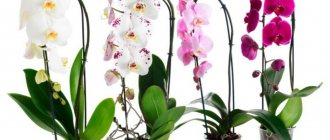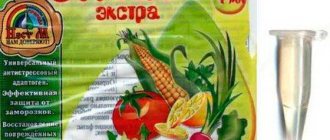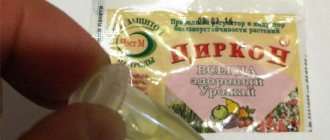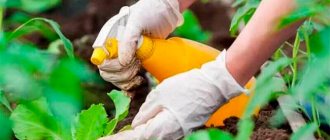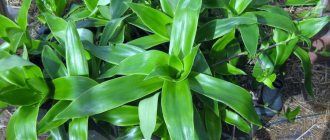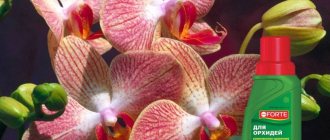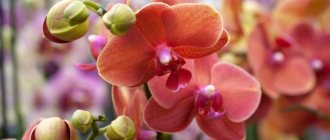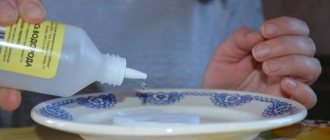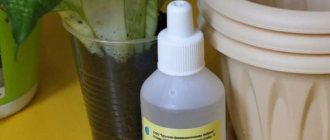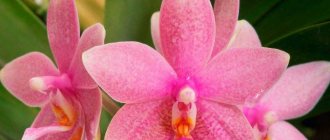Monopotassium phosphate for orchids
From a chemical point of view, potassium monophosphate is a potassium salt of orthophosphoric acid - KH 2 PO 4. As a fertilizer, it is used to provide plants with macroelements - potassium and phosphorus.
Potassium monophosphate is a widely known fertilizer for flowering indoor and garden plants.
Elements necessary for successful color formation
Which fertilizer is best for orchids? In order for a plant to grow a flower arrow, it must receive the necessary elements in the form of :
All of them are involved in the growth of the peduncle and their percentage content in mineral supplements is usually indicated on the packaging . In all fertilizers intended for orchids, these elements are collected in the required proportions, where nitrogen has a smaller share, which is reduced by almost half:
- Nitrogen is an essential element, important for the formation of leaf blades and their proper growth. Since normally developed leaves are the key to good nutrition of the bush. Its deficiency can be determined by small, unformed leaf blades;
- Phosphorus is the factor that influences the formation of the peduncle itself and without its participation it will not appear at all. It also affects the number of buds and the duration of flowering itself. The lack of an element can be seen in the appearance of the bush. He is depressed and practically does not grow;
- Potassium is responsible for proper and complete metabolism at the cellular level of the orchid. Develops immunity in the plant to various diseases that are inherent in this type of plant. If the buds bloom poorly and have a small diameter, then this is a lack of potassium.
Before purchasing fertilizer, pay attention to the expiration date.
When choosing fertilizers for Phalaenopsis, you need to pay attention to :
- For marking;
- Who is this mineral supplement intended for?
- For expiration date;
- And on the percentage composition of these three main elements.
Read also: French name for meat
So for spring fertilization, the nitrogen part should predominate or be at least on par with the other two main components. In the fall, when preparations are underway for flowering, fertilizer with a large amount of phosphorus is selected.
Nitrogen fertilizers
Common nitrogen fertilizers for orchids:
- Substral Orchid Food for orchids;
- Bioekor for orchids.
As can be seen from the characteristics, nitrogen predominates in these fertilizers and is used in the spring during the vegetative growth of the plant.
When should it be applied and in what proportions?
Nitrogen fertilizers are applied at the moment when the flower’s dormant period ends and it begins to grow its foliage. This usually begins with the beginning of spring, since at this time, with an increase in heat and light, dormant buds wake up and sap flow begins.
Feeding scheme
Nitrogen fertilizers are applied twice a month, and they are diluted as indicated on the package, without increasing the dosage. Since this can lead to the death of the plant.
Potassium-phosphorus fertilizers
Popular potassium-phosphorus fertilizers for orchids:
- Uniflor-bud;
- Fertika (kemira) for flowering plants.
Phosphorus-based fertilizers for orchids are often used.
Fertilizer Flower Happiness is also popular; many customers leave reviews.
Methods of depositing and deadlines
Such fertilizers begin to be applied with the arrival of autumn. There are two methods of fertilizing:
In the first case, the diluted fertilizer is poured into a suitable container and the orchid is placed there for a period of 20 minutes. In this case, from time to time it is necessary to shed the soil from above while this time passes. This is done so that the soil (bark) gets wet evenly . Then the flower is taken out of the container with fertilizer and the water is allowed to drain completely, tilting the container with the plant at an angle of 45 degrees.
In the second case, the foliage is sprayed , and water is removed from the axils of the Orchid so that the trunk does not begin to rot.
Monitor the amount of moisture applied to the leaf surface and remove excess to avoid rotting spots.
Scheme
Fertilizers are diluted according to the instructions printed on the package, without increasing the dosage, as this can lead to the death of the orchid bush. Fertilize the orchid with phosphorus-potassium fertilizers every 10 days.
Risks of overdose
It is better to underfeed an orchid than to overfeed it. When overdosed with fertilizers, its foliage shrinks, after which it turns yellow and disappears.
It is better to underfeed orchids than to overfeed them.
In this case, it is necessary to immediately begin resuscitation of the plant, since it will not help itself.
Can it be used during flowering?
How to fertilize an orchid during flowering? You can fertilize your orchid with a large amount of potassium and phosphorus - this will help extend the flowering period and the formation of buds.
If such preparations are applied regularly, the flowers will have a more saturated hue and open fully, gaining diameter according to their specific description.
Therefore, you should pay attention to liquid fertilizers that will help extend the period of budding and flowering . Fertilizer must be carefully applied during flowering.
How to use?
Such preparations are administered with the beginning of the growth of the flower arrow and continue to be used throughout the period of bud formation. Fertilizers for flowering are applied at a rhythm of 2 times a week. This is especially important if there are 2-3 peduncles on the bush. In order for the plant to have enough strength, it needs help in building up the flower mass.
Consequences
When the buds are completely dissolved, you need to stop feeding the flower , as this can lead to premature aging of the flowers and they will begin to wrinkle and wither. At the same time, getting liquid on the flowers can ruin their appearance. Light brown spots will appear on the petals.
Fertilizer composition and effect on indoor plants
Monopotassium phosphate includes:
| Potassium | 30% |
| Phosphorus | 50 – 55% |
Thanks to phosphorus, the following vital processes occur in all plants, including orchids:
- The regrowth of young and strengthening of adult roots improves;
- The synthesis of chlorophyll, cellulose, starches and other substances that are responsible for full growth and flowering is activated;
- Pigments characteristic of the variety are intensively produced. With enough phosphorus, the flowers grow large and bright.
The main role of potassium is to strengthen the cell membrane. Due to this, a sufficient amount of moisture is retained in the tissues, which ensures full turgor (elasticity) of leaves and flowers. The water supplied during irrigation is fully absorbed by the plant and is well retained in the cells. Therefore, the frequency of irrigation can be reduced.
In addition, potassium is called a plant protector . By forming a dense cell membrane, the element helps strengthen all organs, they become impenetrable to pathogens and are much less damaged by pests.
Thus, potassium monophosphate is not only a supplement, but also a means of protection against adverse effects. Its use gives the following results:
- Fertilizer added to the substrate activates root formation and survival of orchids.
- Application during budding promotes the formation of large flowers.
- Improves the size and quality of blooming buds, and prolongs flowering time.
- Has a preventive and protective effect against diseases and pests.
- Helps orchids tolerate unfavorable conditions - lack of watering, temperature changes and other discomfort.
Which is better to choose and why?
The most popular fertilizers for orchids have been listed above. Now we’ll tell you where to choose. There are several parameters for an ideal fertilizer:
- Acidity – should not be higher than pH 7 and not lower than pH5. Otherwise, the plants do not receive the necessary nutrients. If the environment is too acidic, the concentration of substances exceeds toxic levels.
- The concentration of nutrients should be reduced compared to those fertilizers that are used for indoor plants, but should not be too low, otherwise the orchids will suffer from a lack of nutrients.
- The product should contain substances that prevent the accumulation of salts in the bark.
- Microelements must be in chelated form. Please note: iron microelement chelates must be present.
- The product must have additional innovative components. With their help, flowers will grow better.
- Choose fertilizers that come in liquid form because they are easy to apply. You don't have to measure or weigh anything. If we talk about sticks, the release of nutrients in them occurs unevenly.
- It is better if the main plant nutrition is mineral.
If you regularly feed orchids with fertilizers, they will grow well, bloom lushly and beautifully. The products also protect them from diseases and pests.
Release form
Monopotassium phosphate is available as a white powder or light brown granules.
Different manufacturers package it in bags or plastic containers.
Since the fertilizer is designed to feed garden plants, it is produced in large volumes. Minimum weight – 0.5 kg.
Monopotassium phosphate is produced in two forms, as white powder or small irregular granules.
When and how often should you feed your pet beauty?
Before applying fertilizer to an orchid, you need to take into account the seasonality, condition and composition of the soil. There are the following indications for the use of fertilizers:
In the old soil, a constant microclimate has formed with various fungi and microorganisms that also process minerals. If fertilizers are frequently applied to such soil, minerals will begin to accumulate and become salty, resulting in the death of the orchid. So, the older the plant, the less frequently you need to fertilize it.- If the flower was recently transplanted into a self-prepared substrate treated with boiling water, then feed the plant with nitrogen.
- If the soil contains a lot of polystyrene foam or other synthetics, then fertilize more often.
- How to feed an orchid in autumn and winter is a matter of your personal choice; the most important thing is to remember that during these seasons the plant should be fertilized no more than once a month. At this time, dormancy sets in and the flower grows slowly, therefore, nutrients are consumed in small quantities.
- As soon as spring comes, the plant begins to come to life and accelerates metabolic processes.
The absorption of nutrients occurs much faster, so the orchid will need a new dose of feeding. In spring, it is necessary to use preparations for foliage and flowering, applying them 2 times a month. In summer, flower development slows down again, so adding nutrients once a month is enough. Read about what fertilizers are needed for a plant to bloom here.
You will find all the details about how and what to feed an orchid at home in this article.
Preparing for work
If powder is used to feed orchids, it should not be dissolved in hard water. Rainwater, filtered, without chlorine is best. If you don’t have one, you can use boiled and cooled.
Unlike powder, granules dissolve in water of any hardness without negative consequences for orchids.
The working solution is prepared immediately before use. Due to their high activity, substances quickly disintegrate and evaporate.
Tip #1 . Note! In dry form, the fertilizer can be stored without expiration date.
For indoor plants, it is better to buy packaging that closes tightly after the required amount of powder has been taken from it.
How can you feed the plant?
Products for feeding orchids can be specialized or popular. Let's consider each of the options.
Specialized products include a complex of vitamins, microelements and other nutrients. As a rule, a special solution is prepared with their help.
As for folk remedies, we offer you several of the most effective:
- Lemon or pomegranate peel - leave 50 grams of peel in a liter of water for 24 hours, and then use it as fertilizer.
- To boost the immune system, dissolve an aspirin tablet in a liter of water and spray on the foliage.
- Take a liter of settled water and dissolve a teaspoon of sugar in it. Water the plant with the solution once a month.
Methods and frequency of use
Potassium monophosphate is used for root feeding and leaf spraying.
If fertilizer is added to the substrate (soil) for orchids, prepare a working solution based on:
- 1 g per 1 liter of water.
This feeding replaces regular watering.
Feeding is applied following the following recommendations:
- The orchid is fed for the first time as soon as it comes out of dormancy and a peduncle with buds appears.
- A repeat session is carried out at the beginning of the buds blooming.
- Another nutrient watering is planned at the height of flowering.
Potassium monophosphate should not be used when the plant is dormant or has been infected with fungal or bacterial diseases. Because pathogenic microorganisms are activated in the presence of phosphorus and potassium. The elements contribute to the rapid development and growth of pathogens.
It is better to use fertilizer as a preventive protective agent . For this purpose, fertilizing is used for foliar spraying .
For this purpose, prepare a solution whose concentration is 3 times less than for root watering.
This means that 1 g of fertilizer must be diluted in three liters of water. To apply the solution to the leaves, use a sprayer with a fine nozzle. The liquid flow rate is determined until a stable cover is formed on the plates. The fertilizer should not be allowed to collect in large drops and flow down. In this case, processing will be ineffective. Moreover, the active substance evaporates quickly, so it is important to retain it using uniform spraying.
The first feeding is carried out after the orchid has completely taken root.
Preventive feeding begins after transplantation, when complete rooting has occurred. The fact that the orchid has taken root can be determined by the growth of two or three new leaves. Then, for the first time, spraying is carried out to strengthen the tissues of young plants.
Repeated treatment will be needed in about a month. Do not apply fertilizer too often. An excess of nutrients negatively affects the general condition of plants. For example, the color of leaves is disturbed and rapid aging occurs. Instead of prolonged flowering, the opposite effect is obtained.
When to fertilize?
How to feed the plant directly depends on the time of year. So, in winter, one feeding per month is enough. Air dried out by heating, lack of light and drafts do not affect the well-being of plants in the best way, so they fall into a state of dormancy. At the end of winter, beginning of spring, orchids begin an active growth phase. As a result, the foliage is actively growing, but the plant itself is still weak after hibernation.
You need to feed the flowers in the first week after it begins to bloom. This restores vitality and prevents yellowing of the leaves. In autumn, during flowering, foliage and aerial roots are fertilized. From the beginning of September until November, the flowers are fed once every two weeks. They are also fed twice a month during flowering periods, but only with products that do not contain nitrogen.
What exactly to feed the flower in autumn, winter and at other times will be discussed further.
Precautionary measures
Potassium monophosphate cannot be considered a harmless substance. Working with it requires the use of personal protective equipment (PPE). The following must be protected from volatile substances:
- Eyes , tight-fitting plastic glasses;
- Respiratory organs using a mask;
- Hands with rubber gloves.
PPE will be needed to prepare the working solution and during the main feeding. During the work, it is necessary to remove unauthorized persons who are not protected by equipment. This is especially true for children.
If the liquid accidentally gets on the skin, rinse with plenty of warm water.
Successful orchid care
The quality and size of growths are rarely affected by fertilizers. As an example, a healthy, overgrown plant with excellent root growth can produce “horse growth” without feeding at all. I have an old dendrophalus with .. twenty bulbs that has existed for a long time in complete autonomy, I stopped feeding it a long time ago, because if I feed it any more, it will be the Eiffel Tower. Already now the bulbs are three to four times larger than once upon a time “bought.”
And vice versa - if the plant is weak, with dead roots, with a very small number of bulbs - you can at least feed it with the best and most correct fertilizer, but it will still produce frail, underdeveloped or small growth.
So don’t look for reasons in fertilizer when it comes to orchids. They need so little of all these substances that even in any “wrong” formula, they will always find something to eat to their fill.
The best fertilizer is a healthy plant with a strong root system. If this is not the case, then chemistry does not help much. Also, fertilizer cannot help at all when the plant has a tendency to degenerate (shred). Again, it is impossible to correct this situation with fertilizer. You can only prevent this from happening with proper care.
Therefore, you shouldn’t place too much hope on fertilizer. It is only a very weak assistant in the difficult orchid business, and only when everything is fine. And when it’s not good, it can become a pest.
In your specific case, I wouldn’t look for the reason in the fertilizer either. She's clearly not into it.
For beginners, until they clearly understand the cycles, what, why and for what, and when - the plant does - it is better not to play with different formulas, there is a high risk of unknowingly messing up and feeding new growth with nitrogen at the very moment when it could lay a flower bud , and this will bring down possible flowering. That is, deeper knowledge is needed, and not just - it’s growing, so we’ll give it some nitrogen now.
In order not to be mistaken, a balanced feeding is ideal, where all elements are without distortions, in approximately equal proportions. Feed only when the plant needs it, and not according to the instructions on the bottle. (topic - relevant - was) And remember that it is ALWAYS better to severely underfeed an orchid than to accidentally overfeed it.
I wouldn’t recommend the Uniflor series for orch at all. Take a good look at the composition - they have packed in a very decent amount of sodium (why the fright is not clear, since sodium is generally not added to fertilizers). Rare plants generally tolerate it well, and orchids are especially not one of them. For a gardener, I would risk it, but for exotics, it’s a no-brainer to walk through a minefield.
Look for a quality hydroponics fertilizer. The sweetest thing. The main thing is not to be “leftist”. ETISSO is doing good work so far.
Just in case, for your specific case
